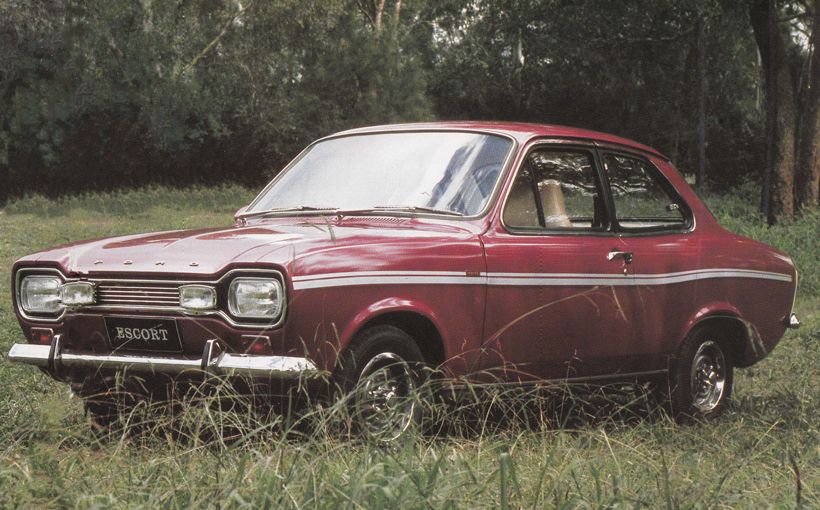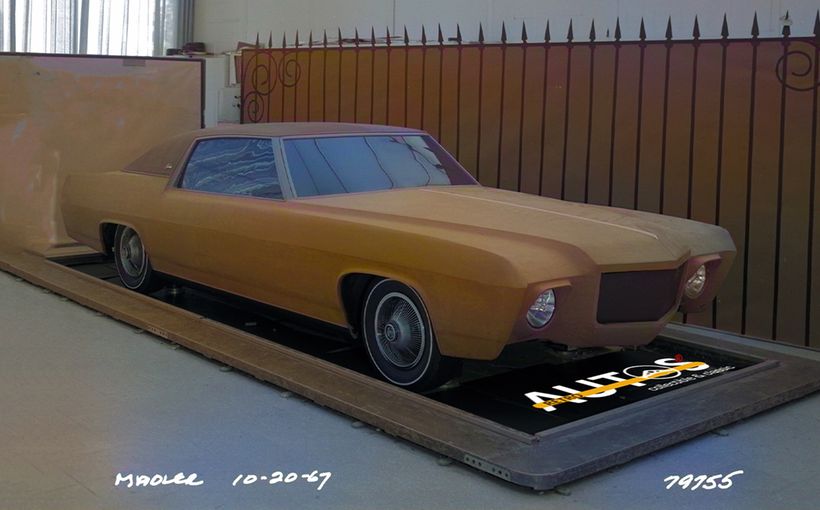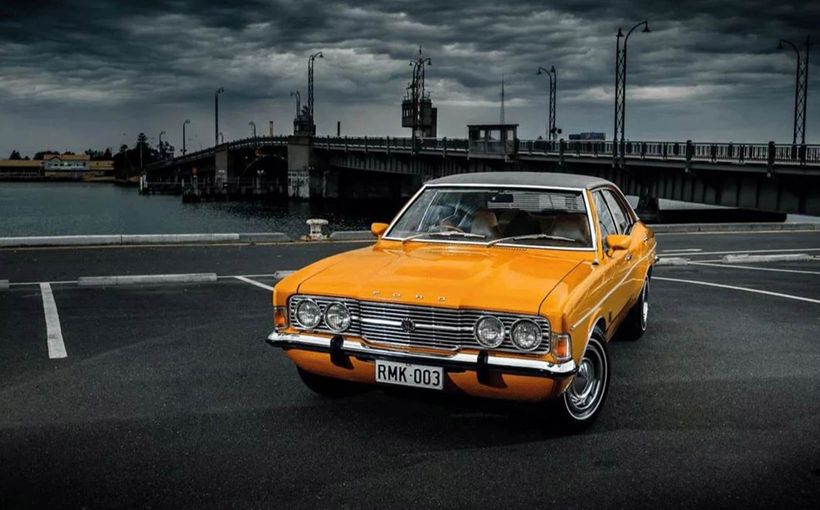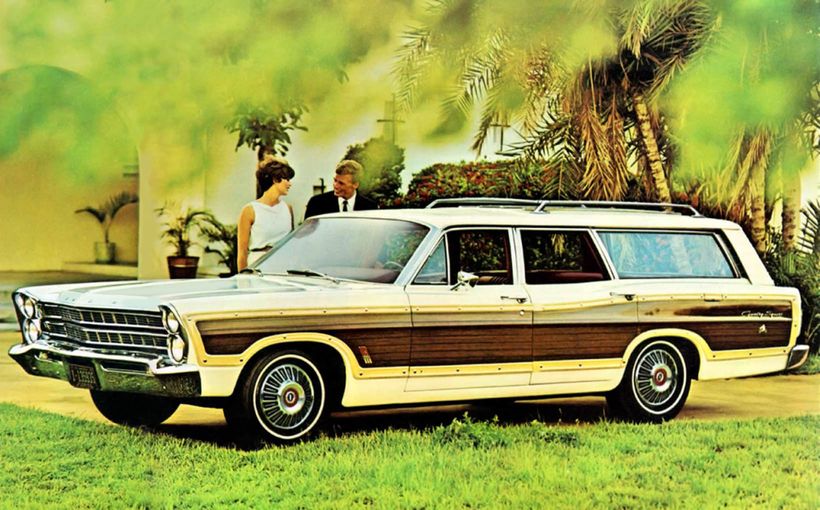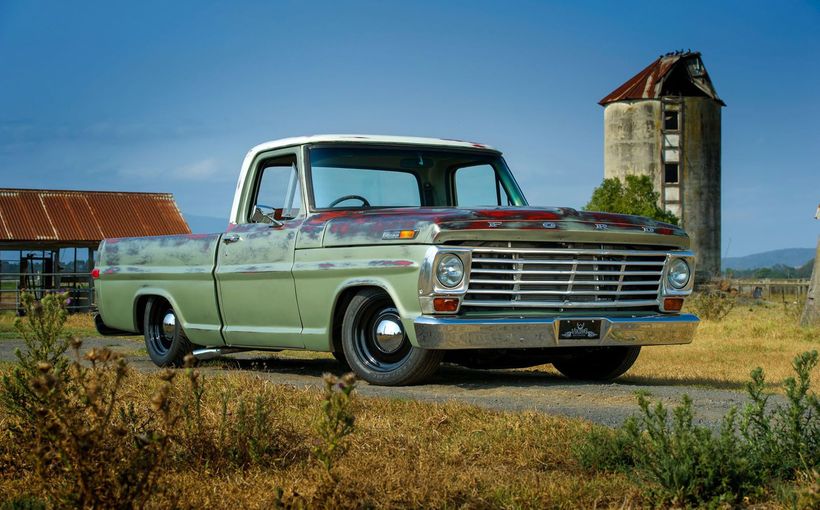1970-75 Ford Escort Mk I: Made In Australia Made the Difference
By
JoeKenwright -
16 February 2015

Australians had to wait several years before being offered an Escort as good as this late model example under the 85 per cent local content plan. The early cars which shadowed the British specification except for local trim and paint were way off the pace in finish and value for money despite their substantial free kick under local content rules.
After the Escort Mk I was launched to the world in January 1968, it took until March 1970 for it to reach Australia. For a car already two years old when it got here, it was a welcome addition to the small car battleground with its fresh styling and interior but not its poor equipment and finish. Changes to local import laws allowed Ford to build it to the required standard at Homebush, NSW, Ford’s new small car manufacturing centre previously the home of the Galaxie.
Everywhere else, the Escort was the much awaited replacement for the popular Anglia 105E, a model finally overrun by a more competitive Vauxhall HB Viva in 1966, a model seen locally as the HB Torana in 1968. Like the first Cortina, it was another class-buster. It almost matched the room of a Morris 1100 then matched its engines for the price of a Mini, a positioning that would be repeated in Australia.

Ford went out of their way not to show you what the basic Escort looked like until it could source the local parts to build it properly. Imagine this car with every item of chrome deleted including glass surrounds, no mirror and tiny 12 inch wheels/tyres with basic hubcaps. The press wanted to support the newcomer as the basics were good but the Japanese were setting new standards that the British had yet to take seriously.
Although the Anglia was a popular small car in Australia, new import rules required 95 per cent local content to be phased in from 1964, ready for 1965. They changed the Australian market dramatically. The rules may have been successful in forcing some companies to increase their local commitment, they also reduced the choice of affordable cars. The high local content requirement also made it unviable for manufacturers to introduce vital new improvements if they upset the local content equation.
In the time it took to recognise that these rules placed Australia in a backwater and left local companies vulnerable to more up to date imported competition, several local manufacturing and assembly operations were sent under.

The Escort was a replacement for the Anglia 105E. Built in Australia with limited local content, its new styling and Kent mechanicals were a welcome advance for 1960. By 1963, it was overshadowed by the Cortina and Ford had to slash its price from $1734 to $1598 at which point it became attractive to the WA and Victoria Police forces as a local runabout. (Photo from Anglia-models.co.uk)
By 1965, the Anglia was approaching the end of its model life. It didn’t add up to manufacture such an old model in Australia with 95 per cent local content. Along with the Zephyr Mark III, it was curtains for the Anglia during 1965, even though both were locally assembled. For the Zephyr Mark III, it was also its last year globally and the
XP Fairmont was a worthy replacement. The Anglia still had two years to go elsewhere leaving Ford Australia without an obvious entry level contestant.
Clever product planning allowed Ford to build the
Cortina Mark I locally to meet these new requirements including a stripped-out Anglia replacement from the Cortina range. The Cortina 220, despite its austerity, tempted buyers with a bigger car than usual for its price. This was during an era when the biggest and cheapest for the least money mattered.

The missing link. Ford of Italy was not prepared to wait for the Escort then watch Anglia sales slump as its dated appearance caught up with it. Michelotti was contracted to smooth out the Anglia’s oddball lines for the 1965 Anglia Torino. If nothing else, the Torino exposed Vauxhall for doing little more to create the HA Viva. (Photo from Anglia-models.co.uk)
By 1970, that had changed. The 220 was dropped and the Cortina Mk I was also looking old. The strategy of stripping a bigger or better car of core features was no longer enough to win buyers if smaller rivals were offering a more complete package. Well-equipped Japanese opposition marked the end of the road for stripped-out local Beetles, Minis and Cortinas.
Ford was also facing much bigger problems in this segment. Holden had cleverly re-engineered its HB Torana range into the
LC Torana with a choice of four and six cylinder models. And even if the coming Cortina Mk III (known in Australia as the TC) had the potential to challenge the top end models from the local Torana range, the British 1.3-litre version was not suitable for Australia. A bigger TC Cortina 1.3, in the unlikely event that it could be priced right, would have seen Ford offering the equivalent of a jack hammer to crack a nut in the Corolla class.
At this critical point, a change in local content requirements opened the door for one of Ford’s most cohesive and progressive model ranges in local history.

The Escort was another brilliant minimalist Ford unitary design without the initial weaknesses of the first Cortina. It required careful assembly if the shell was to emerge with the specified strength and lack of rattles, something the British were not always up to. As this cutaway shows, it was not designed for the twin-cam engine or the Panhard rod rear axle location needed in later years. It was the second of several British Ford designs that gave local Ford staff some major headaches before it was sorted.
Ford’s Best and Most Consistent Local Range Ever
The Ford Anglia 105E, a model that gave many Australians their start in competition, ended production in the UK in November 1967. The Escort was its direct replacement and arrived to a huge pool of good will generated by the Anglia.
The Escort was 3in/7.5cm longer, 4in/10cm wider and 2in/5cm lower than the Anglia. It was a totally new design in its own right picking up only the 1300 engine from the Cortina. It was Ford’s first with rack and pinion steering, a feature highly praised at the time.
Ford also cut costs by pressing the entire section rear of the windscreen scuttle as a single panel on the initial two-door body style. It was soon followed by a four door model which made more sense than most cars at the price as there was the space and a rear seat worth accessing. Partly because of this development, partly because it was pitched against the HB Viva, its clean unassuming styling has survived the test of time.

This is the base Escort cabin Ford didn’t want you to see. Local comparisons didn’t pull any punches about the cost-cutting that had gone way too far even for 1970 while acknowledging the integrity of the chassis and drivetrain. The dash padding had gone, the seats woefully uncomfortable and there was no glovebox. Ford got the message.
The trans-gender Escort Mk I was one of the very few cars from this era at the entry level of the market which a full strength adult regardless of age or gender could feel good about driving.
One of the later Australian Escort brochures was shot at a wedding. The newly-wed couple were shown about to take off in the latest XL four-door while the older vicar was shown stretching on his driving gloves about to leave in his heavily-optioned 1300 XL GS two-door. Younger owners of both genders were shown with the other models. It was an accurate insight into what the Escort had become for Australians. This was no accident.
After it was decided that Ford of Germany and Great Britain would no longer produce duplicate vehicles and models that competed in the same segment, the Escort marked the first joint passenger model following the successful Transit light commercial collaboration. The Escort name also reflected a move away from the Anglo-centric Anglia badge.
Its design was subject to a fierce competition between the British and Germans. After the British anticipated what the final arbiters would be looking for, the British produced the winning design.

Although the early Super cabin looked much better finished, the same seats were still under the fancier trim and the lack of insulation throughout the car made it feel tinny. The Super pack was well worth the extra though.
The man responsible was Ron Bradshaw, a former Rootes Group designer who gave the world the Hillman Minx Californian as the Rootes Group desperately tried to add some glamour to its old stodge for US exports before the new Loewy designs came on stream. Before the Escort, Bradshaw worked closely with Michelotti on several designs.
No single direct Escort design influence can be readily cited but the “dog bone” or “barbell” grille not only linked the Escort to Ford’s own Capri (which reached Australia first but in Europe came after the Escort), it also recalled several expensive European cars which had their headlights raised slightly above the grille. It achieved this by not raising the headlights at all but by cleverly making the grille thinner than the headlights and sloping the bonnet to suit. As a result, the Escort looked just as good with circular or round headlights in both the UK and German contexts.
The trans-Atlantic body profile combined GM’s latest curved sides and Coke-bottle hip line with Ford’s short-boot, long bonnet Mustang proportions. Its simple horizontal tail lights shared a family link with the Capri and a number of Australian Fords over its model life.

Early Escort GT and Twin Cam cabins looked the goods but the same seats remained. Steering wheel obscured extra instruments. Even if the local 1300 GT was a step above the British version, it needed the Cortina GT’s 1.6-litre engine to justify the extra insurance and price.
Most dimensions shadowed the HB Viva but because the Escort was lighter than comparable Viva/Torana models, it was usually quicker and more frugal. Escort engines all benefitted from the
Mark II Cortina upgrades including the five bearing crankshaft, bowl in piston combustion chambers, cross flow heads with inlet and exhaust valves on opposite sides, water-heated inlet manifold and oversquare short stroke configuration. Even the cooking engines revved freely beyond 5500rpm.
The standard manual gearbox was Ford’s new German-designed, British-built single rail four speed all-synchro transmission. Along with the sharp steering, it was one of the car’s standout features.

Local GS pack was an attempt to add an emotional component and link the Escort range with its growing global motorsport legend. In reality, it added what should have been part of the 1300 GT and Twin Cam anyway. Ford UK, like Holden in Australia, had legendary sales teams that could sell an underdone car on motor sport conquests. Because Aussie Ford fans were more concerned about the Falcon GT and the Japanese had raised local expectations so high, the local Escort needed extra substance as much as a GS pack.
The critical factor in its local introduction in 1970 was the shift in local content requirements from the end of 1968 that no longer tied vehicle production numbers to a 95 per cent local content. That figure eased to 85 per cent. It allowed Ford to introduce both the Escort and the next Cortina within a year of each other.
Because of local marketing guru and later Ford Australia President Bill Bourke’s pioneering work in linking such a diverse range, the Escort became a vital local entry point for Ford. It was a new reason for a much younger buyer group to enter Ford showrooms. The cheesy tag line “It’s a little gas” reflected that.
Before several last minute influences within the Ford world disrupted the simplicity of the Cortina Mark III (TC), Ray Bradshaw again headed the design team that locked in the new shape, hence the similarity in profile if not details.

This shot in 1971 would have created a warm glow around Australia. At last, a wonderful and modern Ford passenger car range that looked like it was from the same family as Falcon. Each model appeared to offer the same standout Ford features regardless of which one you chose. By the end of 1971, the Ford team were working around the clock to restore some integrity to the TC Cortina while Capri sales went into free fall. The Escort Mk I survived relatively unscathed after it responded well to local improvements.
By 1971, Ford Australia was offering an Escort, Cortina, Falcon, Fairlane and US LTD clearly linked by shared Ford DNA. This relationship strengthened in 1972 after the
XA Falcon and its many derivatives picked up several of the design cues of both the Escort Mk I and TC Cortina. Although there were initial assembly and quality issues with both British models, they collectively provided clear and distinct reasons for buyers of all ages and both genders to enter a Ford showroom, something lost in more recent years.
As for Ron Bradshaw, he was brought to Australia later to work alongside Ian Callum (later of HSV, Aston Martin and Jaguar fame) and Peter Arcadipane (lately of Mercedes-Benz) to help finish the EA26 Falcon program. After he was told to then report to Ford of Germany, Ron Bradshaw elected to retire and make his home in Australia.

By 1972, the base Escort was called the L, a model that Ford Australia could promote after it picked up most of the features of the previous Super model. Extra exterior detailing meant that you could take one home and still be proud of it, something that couldn’t be said about its predecessor.
By 1967, British Anglia sales had tumbled to 55,735 units compared to the HB Viva which sold 100,220 that year. In its first full year in 1968, the Escort comfortably more than doubled the Anglia figure in the UK but it was less successful in Europe where a range of more sophisticated and affordable small cars from Fiat, Opel, Peugeot, Renault and others made the going much tougher.
The Australian market was even more discerning than both the UK and European markets. The Escort faced a strong contingent of European and Japanese rivals and the market had moved on from the bare bones presentation, restricted colour range and minimal equipment of the British market cars. From the day the first Escort hit Australian assembly lines, Ford Australia was under constant pressure to add value and quality.
After Ford Australia’s constant efforts, the Escort Mk I in Australia could always be counted on to generate 10-12,000 units per year, good figures in a segment under attack from every direction.

Family shot of Australian Escort range suggested with some accuracy that there was an Escort for buyers of all ages and both genders. Bright Aussie colours, lots of chrome and plump, comfortable seats were a world away from what was on offer two years earlier yet at much sharper prices.
The Australian Escort Range
After talking to Ford veterans whose job it was to make sure that the Escort didn’t break under local conditions, the consensus is that it arrived here unusually sturdy for a small British car, a product of the two year delay for it to reach here. By 1970, lessons from the rally program were filtering through.
However, as with the Cortina, the Escort’s minimalist construction was heavily dependent on the quality of assembly. Ford Australia discovered very quickly that there was little margin for error in the assembly process.

As presented here, the Escort XL in a bright XA or XB colour came equipped exactly as you would want including 1300 engine and front disc brakes. Although the wider rims and tyres were good enough for most, Ford also gave you a radial-ply tyre box to tick.
The Australian body came with fixed quarter vents and a cheaper version of the Cortina’s benchmark flow-through ventilation. Despite the design’s sophistication, air flow volumes were barely adequate for English conditions and nowhere near high enough for local heat. The two door with its fixed quarter vents and side glass left owners with few alternatives with the rear seat occupied. The four-door was a better deal in this area as the rear windows could be wound down. Ford Australia was on a mission to address the design flaws in the system.
Australian cars all had square headlights. Wheelarches on all local bodies were designed to clear a range of 13 inch Twin Cam wheels, a benefit for the many enthusiasts attracted to the car ready to toss the standard 12 inch rims. Vital to the Twin Cam’s local existence was the ability to add the imported Lotus powertrain to the local Escort body but more of that shortly.
Later British Fords were too often a combination of panels and parts of variable quality sourced from a number of different Ford plants that Ford Australia somehow had to make fit. The Escort Mk I was assembled from consistent panels and parts and built tough even if there was the occasional assembly glitch typical of the times.

Escort van was a development of the previous high-roof van based on the Anglia. It had a totally different body to the low profile Escort wagon body not sold in Australia. It was perfectly placed to exploit the panel van as a lifestyle choice with the GS pack.
Initial local deliveries were only slight variations of the English specification, picking-up Australian paint and trim and other less obvious components while the design and appearance of the body and cabin remained largely British. This changed very quickly in the race to achieve 85 per cent local content. By 1972, the Escort was sharing more Falcon/Cortina/Capri components including trim, front high back seats, mirrors, colour range, electrical parts including horn and others.
As Ford engineers sourced more local components, they treated this as an opportunity to upgrade parts for local conditions. Springs, dampers, brakes, tyres, exhaust system and its mountings, electrics, batteries and certain structural parts were all upgraded.

It would be hard to find another car in the Escort class with seats and trim as plush as this. This is the final XL interior with the later lateral pleat stitch pattern.
Beyond that, the biggest factors influencing local versions were ADR requirements (heater-demister, windscreen washers, safety steering column, seat belts, head restraints were just some of the items that had to be standardised across the range) and the new tariff laws. While the lower 85 per cent local content appeared to make it easier to build a local model, there was a nasty little clause that could undo an entire model range.
It was called “substantial component differential”. It was the one that forced Peugeot to drop the 404 because it was deemed too close to the 504 and Renault to make the R12 engine smaller because it was too close to the R16. The impact on the Escort range was no less significant.
Ford’s latest 1.6 cross-flow engine had already appeared in the Mark II Cortina in standard and GT specification locally. It would have been logical to position the Escort Mk I as a class-leading 1.3-1.6 range (as the Holden Gemini and Escort Mk II would later become) from the start. The rules wouldn’t allow an Escort 1.6 crossflow option in standard or GT specification as it was deemed too close to the Cortina 1.6 and the Escort 1.3.

Another shot of the base Australian Escort L later in the Mk I model life.
As a result the feeble 1100 engine (53bhp/39.5kW) was the base local engine and the 1300 (61.5bhp/46kW) became the option. The GT’s twin-throat Weber, higher comp, high-lift camshaft and extractors had to then be applied to the 1300 which lifted this to 75bhp/56kW.
Although the 1300 GT had a worthwhile performance boost (18.8 second standing quarter), it was not a GT in the usual Ford Australia tradition despite the later addition of SuperRoo decals. It certainly did not justify the steep insurance premiums that came with the badge and was no substitute for a cheap Torana 6. The 93bhp/69kW of the 1600 Cortina GT was a no-brainer for the Escort GT if it wasn’t for these silly rules.

Late model Escort L cabin following Australian improvements. Compare it to the base model above as first presented to Australians. Time was running out for the Mk I and its 1300 engine as the new Holden Gemini 1600 was about to set a new benchmark.
This also explains the unusual local marketing of the top shelf Twin-Cam model as it was the true GT yet appeared as a stripper track-ready model. It could be offered because its Lotus twin-cam engine was very different to that of any other local Ford model or Escort. It was positioned as a specialist model for enthusiasts with a motor sport bent as well as a Torana GTR alternative.
The hefty price premium could be capped by fitting the imported Lotus-Ford engine and gearbox into the Australian body. The engine reflected the Mk II Cortina Lotus spec with 115bhp/86kW. It didn’t sell well as it was compromised as a road car. Ford’s white collar enthusiast workers recall being offered the Twin Cam as a company car at a substantial discount. They were encouraged to go and play on weekends at club motorsport level which is why so many started life as Ford company cars. It was rebadged as the GT 1600 as soon as the 1300 GT was dropped from lack of interest.

Rare internal Escort sales briefing folder provides an insight into how companies fire up their sales teams. The vital figures missing in this rather rubbery little communication is that an Escort 1100 Super cost $1920 and really didn’t beat the Mini-K or Corolla 1200 in too many areas at all. To outpace the Corolla 1200, you needed the Escort 1300 Super which cost $2010. In its early days, the Escort was not a standout winner by a long shot and buyers needed sales staff to sharpen their pencils and fill in the empty box with a figure under the Corolla to take home either Escort Super model.
The initial range started as the base Escort 1100 for $1770. It was a bleak package with painted, unpadded dash, no heater/demister and rubber mats. There was little chrome outside. For $1920, you could opt for the Super which was an amazing package for the money including pleated and bolstered seats, carpet, rear seat contouring, heater-demister, wood-grained dash , door courtesy lights, extra body chrome and trim rings on the wheels. A four door was offered at Super level only. For $90 on both models, you could order the 1300 engine which came with the same power disc brakes as the GT. When the average option price back then for disc brakes alone was $50, this was also good value.

Even at base level, the local Escort van evolved into a comfortable and practical van that made many friends for work and play. Note late-model Ford Australia mirrors and seats. (fordxr6turbo.com)
The GT and Twin-Cam came with woven grain seats inserts and extra gauges while the twin-bumperettes, rear suspension trailing links and wheel trim rings were exclusive to the Twin Cam. A GS Rally Pack could be added to Super, GT and Twin Cam bringing stripes, driving lights, wheel covers, racing side mirror, sports steering wheel, wooden gear lever knob and a sports “Power Growl Muffler”. The wood trim inside and wild local colours, made the local GT and Twin Cam much more exciting than the UK versions and that’s before you ticked the GS box.

Ford offered a range of campers based on the Escort 1300 van. This was the Escort Outback.
In January 1971, the Super was replaced by the XL with minor trim and dash changes plus extra chrome on the tail. By November 1971, the Twin Cam was repackaged as the GT 1600 after the 1300 GT was repackaged as the Super Luxury sedan with radio and clock to silence GT insurance phobias. The standard Escort became the L.
In January 1972, local ADRs dictated high-back fully-padded seats on all models. The L now had the wood grained padded dash, padded door armrests, classier door trims and standard heater-demister. The rubber mats were all that remained of the earlier entry car inside. Disc brakes were standard on all models but lost their power booster on the L. Trim pattern, paint and seat style reflected the TC Cortina and XA Falcon including the latest family-look streamlined exterior mirror.
During this period, the base Escort light commercial van was offered in several camping versions as well as a GS and a special Little Ripper version. By June 1972, the L had gained separate reversing lights, the XL front seats could be reclined and a radio was standard in the XL. The GT 1600 twin-cam was then phased-out followed by the Super Luxury model. Both had gone by the end of 1972.

The Escort Overlander which left the van with a much higher roof than the Outback when folded.
During this period, blackouts and extra chrome appeared around the XL side glass as the XL’s appeal was broadened to cover off the deletion of the sports models. Tyres and rims were upgraded to GT spec.
In April 1973, the 1100 was dropped and the 1300 was the base and only engine left in the Escort Mk I range.

There were two other less extensive factory conversions, the Escort Sundowner (left) and Sunstar.
At this point, colours and trim were reflecting the XB Falcon. Pick the very last cars by their prismatic cabin mirrors introduced in May 1975 before the Mk II arrived in October 1975. The Escort’s global motorsport success by then had become a major part of Ford advertising and literature even if the various specialist later models were never sold in Australia.

This ad was more accurate than it first seemed after Wheels discovered that the Twin Cam really was a collection of desirable bits but not much more. The Twin Cam generated huge expectations thanks to ads like this but it soon proved far less than the sum of its parts as a road car.
The Aussie Twin-Cam Debacle
What should have been the new Escort range’s crowning glory in the October 1970 Wheels road test of the Twin Cam was the “worst road test of 1970 in my experience” according to tester and editor Rob Luck. So what happened?
- The $3000 purchase price was seen as exorbitant especially after another $234 had to be spent on the GS pack (driving lights, wheel covers, side mirror, stripes, sports muffler) laminated windscreen, radio and heavy duty battery.
- “It was very loose in the body”, the doors didn’t fit properly, paint quality was poor.
- The engine broke loose from its stay and crunched the starter solenoid.
- The muffler repeatedly broke away from its rubber mountings.
- The cam covers leaked oil repeatedly.
- The boot-mounted battery lacked a proper cover and the boot was carrying the signs of two previous fires after luggage had shorted across the terminals.
- The engine was noisy and labouring harshly at high revs and wouldn’t reach the engine speed that overseas models could achieve.
- Placement of cables, electricals and piping was bad. The lack of retaining clips on the joiner hoses for the brake fluid reservoir was “alarming”.
- Standard 9 gallon tank was way too small.
- The sports steering wheel obscured the extra gauges.
- The seats were unbearably uncomfortable and ventilation poor.
Senior Ford staff were galvanised around the country to investigate and converged on the Homebush factory as this reflected on the entire Escort range. You could imagine local Ford President Bill Bourke’s reaction. An April 1971 Rob Luck re-test recorded the following:
- Tight body – no sign of looseness.
- Good door fit – no gaps, easy closing.
- No rattles in body or interior fitments.
- Good trim fit – no gaps, rough edges.
- Excellent paint quality and finish.
- Adequate engine stabiliser bar.
- Properly restrained exhaust.
- No oil leaks from the cam cover. (Ford workers recall having to strip all imported Lotus engines of their valve covers, clearing the old gasket, re-machining the sealing face and applying a local fix)
- Battery cover specific to the heavy duty battery option, an essential extra to counter the extra wiring from the battery’s re-location to the boot to clear room for the Twin Cam engine.
- Reduced noise level.
- Full engine performance in top gear – rev to maximum (Ford had discovered that the carburettors needed re-jetting for local conditions).
- Better performance. Top speed raised from 100mph/160km/h to 118mph/190km/h.
- Improved fuel consumption.
- Improved engine smoothness.
- Improved seats – relocated coils (later replaced by local seats)
- Adequate Falcon horn.
- Great durability and strength.
- Advice to order the Cortina GT sports steering wheel which was a better match for the Escort instrument positioning.

The Twin Cam was repackaged as the Australian GT 1600 after the 1300 GT was withdrawn. It was a much better car but buyers still needed to tick the right option boxes to bring home an example that looked like this.
Areas Still Under Development
- Poor ventilation. (Poor plumbing and design were being addressed with a ram effect under development along with better eye-ball vents)
- Auxiliary fuel tank.
Ongoing Local Improvements Over British Car
- Local sound and heat control material.
- Reinforced floorpan for fuel tank.
- Wire strap to attach temperature sender wire.
- Cable strap for distributor lead.
- Increased capacity radiator and improved support.
- Beefed-up front and rear suspension.
- Stiffened rear engine mount.
- Gussetted rear cross member.
- Vinyl filler for rear bulkhead to improve appearance.
- Reinforce axle bump stop bracket as required.
- Alternator to replace generator as units become available (this was during the period of massive industrial strife across the component industry).
- Local muffler system.
- Local safety changes as manufacturing allowed – including rear seat belts, stop lamp tell-tale, improved heater output.

This photo highlights why the Twin Cam was a nightmare for Australian engineers. The engine was mounted diagonally so the rear Weber would clear the brake master cylinder. The battery was placed in the boot to make space for the power booster. Ford would then charge you extra for a heavy-duty battery to cope with the extra wiring loads but not fit a cover to stop luggage shorting across the terminals. After the Wheels test car threatened to catch fire a third time, the gloves were off for one of the most scathing road tests in the magazine’s history. Lotus also seemed more interested in moving its name to the front of the cam covers for the cross-over air cleaner than curing the oil leaks.
The article went from a blistering critique to one of the best arguments for a local industry.
“The English Twin cam is available in the UK in only one version (white with black trim) and to fully import it to Australia, the market tag would read about $4500. Its basic price when last tested was $3000 – now risen to $3126 and the “necessary” options raise the price still further to around $3280. Fully optioned the retail is $3360.”
“The Twin Cam was dropped on the Australian market with a colour trim/trim combination that makes the English marketing system look pathetically inadequate, and the car also had the benefit of the full Ford Australia optioning system.”

In a bizarre juxtaposition of images, the raunchiest Escort Mk I you could buy at the end was a 1300 XL with GS pack, just the car your vicar would buy. Nothing like honesty in advertising as it was definitely not the car to satisfy the devil in Ford fans.
Conclusion
The Escort Mk I not only provided extra room and a more involving drive over the Toyota Corolla and its Japanese peers, it outlasted several generations of these models on the new car market with very few changes.
It also offered a level of individualisation not available on any other small four at the time. Ford Australia treated its entry level Escort buyers to the same goodies and enhancements as a Falcon buyer. This partly explains the deep loyalty that these buyers maintained as they moved up the range.
This in turn meant that used Escort Mk I examples maintained unusually high used demand until they finally wore out or were scrapped after too many rally-style jumps on country roads!
The classic market is surprisingly devoid of survivor Escorts in original specification and condition as the above photos reflect. As so many of them were cherished and lasted better than most small cars, this is a curious anomaly. The reason is simple.
The Australian Escort body shell with its improvements and relatively little rust is highly sought-after worldwide for historic rally and race cars. A good shell can fetch more than a complete car is worth. Apart from testifying to the never ending global popularity of the model, Ford Australia did get it right in the end.
Although this clip is listed as a UK Escort ad, it was part of the campaign used in Australia to launch the Escort Mk I. The voice over is Australian. The limited range on offer and the scenery also suggest Australia. The first brochure had the same theme: “It’s a little gas!” By the end of 1971, the TC Cortina was winning new buyers as a starter family car or an older couple’s downsized replacement while Capri sales went into freefall. Ford quickly repositioned the Escort – “Ford Escort Fits Right Into Your World” as a small car for everyone.



























